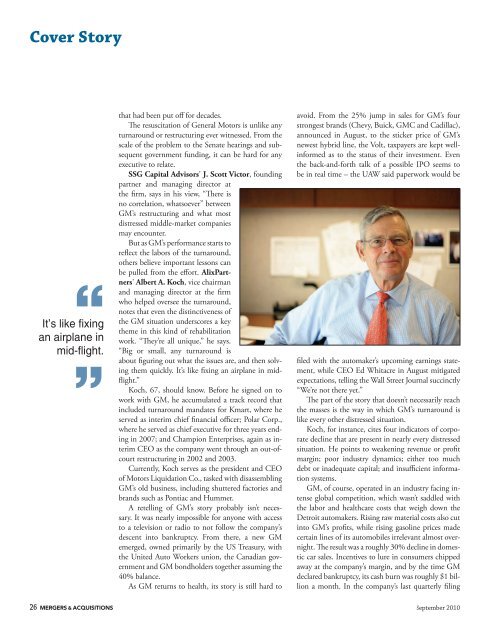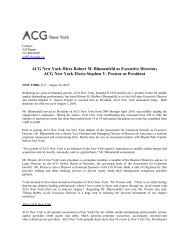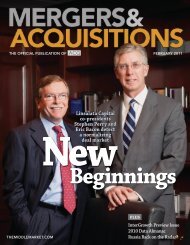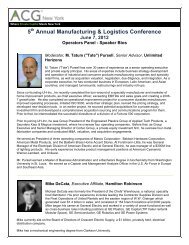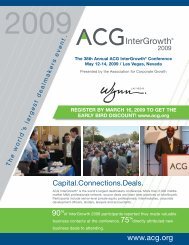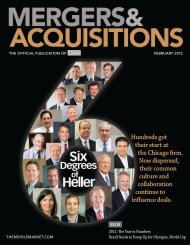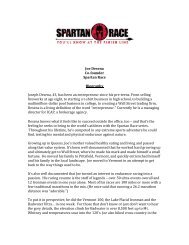September 2010 - Association for Corporate Growth
September 2010 - Association for Corporate Growth
September 2010 - Association for Corporate Growth
You also want an ePaper? Increase the reach of your titles
YUMPU automatically turns print PDFs into web optimized ePapers that Google loves.
Cover Story<br />
“<br />
<br />
<br />
<br />
”<br />
that had been put off <strong>for</strong> decades.<br />
The resuscitation of General Motors is unlike any<br />
turnaround or restructuring ever witnessed. From the<br />
scale of the problem to the Senate hearings and subsequent<br />
government funding, it can be hard <strong>for</strong> any<br />
executive to relate.<br />
SSG Capital Advisors’ J. Scott Victor, founding<br />
partner and managing director at<br />
the firm, says in his view, “There is<br />
no correlation, whatsoever” between<br />
GM’s restructuring and what most<br />
distressed middle-market companies<br />
may encounter.<br />
But as GM’s per<strong>for</strong>mance starts to<br />
reflect the labors of the turnaround,<br />
others believe important lessons can<br />
be pulled from the ef<strong>for</strong>t. AlixPartners’<br />
Albert A. Koch, vice chairman<br />
and managing director at the firm<br />
who helped oversee the turnaround,<br />
notes that even the distinctiveness of<br />
the GM situation underscores a key<br />
theme in this kind of rehabilitation<br />
work. “They’re all unique,” he says.<br />
“Big or small, any turnaround is<br />
about figuring out what the issues are, and then solving<br />
them quickly. It’s like fixing an airplane in midflight.”<br />
Koch, 67, should know. Be<strong>for</strong>e he signed on to<br />
work with GM, he accumulated a track record that<br />
included turnaround mandates <strong>for</strong> Kmart, where he<br />
served as interim chief financial officer; Polar Corp.,<br />
where he served as chief executive <strong>for</strong> three years ending<br />
in 2007; and Champion Enterprises, again as interim<br />
CEO as the company went through an out-ofcourt<br />
restructuring in 2002 and 2003.<br />
Currently, Koch serves as the president and CEO<br />
of Motors Liquidation Co., tasked with disassembling<br />
GM’s old business, including shuttered factories and<br />
brands such as Pontiac and Hummer.<br />
A retelling of GM’s story probably isn’t necessary.<br />
It was nearly impossible <strong>for</strong> anyone with access<br />
to a television or radio to not follow the company’s<br />
descent into bankruptcy. From there, a new GM<br />
emerged, owned primarily by the US Treasury, with<br />
the United Auto Workers union, the Canadian government<br />
and GM bondholders together assuming the<br />
40% balance.<br />
As GM returns to health, its story is still hard to<br />
avoid. From the 25% jump in sales <strong>for</strong> GM’s four<br />
strongest brands (Chevy, Buick, GMC and Cadillac),<br />
announced in August, to the sticker price of GM’s<br />
newest hybrid line, the Volt, taxpayers are kept wellin<strong>for</strong>med<br />
as to the status of their investment. Even<br />
the back-and-<strong>for</strong>th talk of a possible IPO seems to<br />
be in real time – the UAW said paperwork would be<br />
filed with the automaker’s upcoming earnings statement,<br />
while CEO Ed Whitacre in August mitigated<br />
expectations, telling the Wall Street Journal succinctly<br />
“We’re not there yet.”<br />
The part of the story that doesn’t necessarily reach<br />
the masses is the way in which GM’s turnaround is<br />
like every other distressed situation.<br />
Koch, <strong>for</strong> instance, cites four indicators of corporate<br />
decline that are present in nearly every distressed<br />
situation. He points to weakening revenue or profit<br />
margin; poor industry dynamics; either too much<br />
debt or inadequate capital; and insufficient in<strong>for</strong>mation<br />
systems.<br />
GM, of course, operated in an industry facing intense<br />
global competition, which wasn’t saddled with<br />
the labor and healthcare costs that weigh down the<br />
Detroit automakers. Rising raw material costs also cut<br />
into GM’s profits, while rising gasoline prices made<br />
certain lines of its automobiles irrelevant almost overnight.<br />
The result was a roughly 30% decline in domestic<br />
car sales. Incentives to lure in consumers chipped<br />
away at the company’s margin, and by the time GM<br />
declared bankruptcy, its cash burn was roughly $1 billion<br />
a month. In the company’s last quarterly filing<br />
26 MERGERS & ACQUISITIONS <strong>September</strong> <strong>2010</strong>


